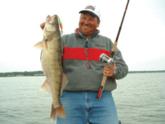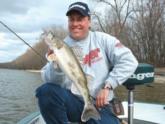Trolling for dollars
RCL pros suggest you pay attention to detail if you want a consistent paycheck

Done willy-nilly and without regard for a whole roster of variables, open-water walleye trolling is more like mowing the grass, eating up a swath of water in a futile attempt to get the job done, than efficiently searching and straining. But you might get lucky on a pass or two and catch a few. Done with aptitude and attention to wind, waves, water temperature and a whole lot more, going for a troll is elevated to an altogether different level, one that dispenses with flash-in-the-pan possibility and yields fish-in-the-box consistency.
Take it from some of the finest trollers on the Wal-Mart FLW Walleye Tour, anglers who approach wide-open spaces with a measure of science, intellect and analysis. They ask what happened and why. They anticipate the fish’s next move based upon prevailing conditions. They study the nuances of their lures, speed and progress with, or at an angle to, the waves.
“The most important thing is to pay attention to the absolute smallest detail,” said Todd Frank, a 37-year-old pro from Pulaski, N.Y., who cashed checks in all four Walleye Tour qualifying events in 2002, including an eighth-place finish in a troll-a-thon on Saginaw Bay in Michigan. “It could be speed, trolling direction, catching a fish on a turn. When I catch a fish, I analyze the whole situation in my head. Was it on a turn? Was the fish on the inside or outside board? Did I have a piece of crawler on the crankbait? Was it a metallic bait or a dark bait?”
On the tour, open-water trolling is an indispensable talent necessitated to a large extent by the destinations on the schedule. With sizable and growing fields of competitors, it only makes sense that the waters are expansive enough to accommodate them, from the Great Lakes to immense inland waters such as Devils Lake in North Dakota, all places with considerable populations of roving walleyes. That’s why, wherever the pros go, open-water trolling for suspended walleyes will probably figure into the outcome. That is, when it’s done right by the most accomplished practitioners of planer boards and trolling spreads.
Into the great, wide open
Make no mistake, the prospect of finding fish on an inland sea is daunting. When there’s water everywhere – more than 1,000 square miles on Lake Huron’s Saginaw Bay – the possibilities seem endless. That’s where and when the primary factors determining fish location are seasonal patterns and the presence of baitfish.
“There’s a lot of water on Saginaw Bay or Lake Erie,” said John Campbell of Marco Island, Fla., who finished fifth last year on Saginaw. “You’re trying to find a section of water with a different surface temperature or schools of baitfish. You’re changing location, and you have to change your presentation while you’re [practicing]. You have to find out if the fish you’re seeing on your electronics are up high, in the middle or down on the bottom. You have to find the right depth for more or bigger fish.”
Following a seasonal pattern, suspended big-water walleyes start out in the spring near spawning areas and later occupy stretches of open water with baitfish foremost among their priorities. Bait and, in turn, walleyes will position themselves near reefs and along drop-offs and contours that facilitate their movements from one location to another – migration routes, if you will. Early in the season, suspended walleyes will be adjacent to, and within a few miles of, spawning reefs. The classic example is the Western Basin of Lake Erie, the third stop on the Walleye Tour in 2003, where walleyes leave the reefs in April and begin a counterclockwise migration about the lake. Likewise, Saginaw’s walleyes begin a progression from the Outer Bay into the Inner Bay come summer.
To find them in either instance, pros like Campbell seek pockets of water that are warmer, particularly in spring, and hold bait, regardless of the time of year. In spring or even in summer on Saginaw, stretches with water temperatures a couple of degrees higher might be enough to concentrate bait and, therefore, walleyes. The bait and accompanying walleyes could be clustered within a half-mile of rock structure, though it’s not necessarily so. The bait might be roaming open water, in the middle of nowhere, with the walleyes right behind them. If Campbell doesn’t like what he’s seeing on his electronics – say, a lack of bait and predators – he’ll pick up and move a half-mile away and keep searching.
Speeding and straining
To catch open-water roamers, the guideline is for long, narrow, subtle-action crankbaits in the spring, with a switch to spinners with night crawlers when water temperatures hit 48 degrees. Whichever it is, and of course with exceptions to any rule, the trollmeisters put great importance on speed – and repeating it and refining it.
“If I have to choose a speed for spinners, not knowing what the fish like, I’ll go slowly,” said Frank, who trolls with the wind or often downwind at an angle, then makes a mental note of when he gets bit in order to do it again. “I’ll set up at 0.8 mph to 1.2, 1.3 mph. I’m going in all directions, trolling in circles. If every fish I catch is on the outside, they want it faster. If they come on the inside, they want it slower. Walleyes are notorious for following, and all of a sudden you start an inside turn and now the bait comes right at him. Does he duck or grab it right now?”
If a fish takes the inside bait when the spinner stalls, it’s a cue to slow down. If a walleye strikes during a turn on one of the outside planer boards, the handy devices that guide lines away from the boat (where the fish typically scoot when you troll over them), it’s an indication they want it faster. Speed as it relates to turns is key to determining the walleyes’ preferences.
Also of crucial importance is the fish’s height in the water column. While it’s possible to watch electronics for how high the fish are cruising, you often have to fish for them, experimenting with bait placement from the surface to the bottom.
 “I’m constantly experimenting, changing the length of line to achieve different depths,” said pro Mark Brumbaugh of Arcanum, Ohio. “My feeling is that when you stop catching fish, they’re running higher or more likely lower. You have to have a gut feeling whether the party’s over or which direction to move.”
“I’m constantly experimenting, changing the length of line to achieve different depths,” said pro Mark Brumbaugh of Arcanum, Ohio. “My feeling is that when you stop catching fish, they’re running higher or more likely lower. You have to have a gut feeling whether the party’s over or which direction to move.”
The most efficient approach is to stagger lures from top to bottom, dividing the water into quadrants. That, at least, is a practice strategy to find fish location in the water column; come tournament time, it’s important to follow the patterns established in practice and to keep moving lures and your trolling location to stay with the fish when they move.
To establish the walleyes’ whereabouts, Tommy Skarlis, an Walleye Tour pro based in Walker, Minn., puts a lure in the top quarter of the water, one down the next quarter and so on. So, if the water is 20 feet deep, Skarlis runs a bait five feet down, another 10 feet down, another 15 feet down and the final one near the bottom. Then he responds to what the walleyes are telling him about where they are and what they want, which is often a particular color.
“The angler who’s being aggressive and active with reeling lures in and putting them out always has a fresh lure out there,” Skarlis said. “I think where we make a mistake in color selection is when we try to establish a norm for it. But the fish will change just when you think you’ve found a constant.”
That’s why, in the search for color preference, the aforementioned pros will run three lines with the same color when they catch a fish or two on a particular shade, and a fourth with something else. In essence, it’s a process of elimination to find out when the fish change their preference or to adapt when conditions, such as sun or clouds, change. The hot color from the day before might not even draw a touch.
To be sure, the thought processes are never-ending in an open-water trolling scenario. How high? What speed? What color? On an inside or outside turn? It’s precisely that penchant for analysis that separates the fine-tuned trollers from those who are out there mowing the grass.
 Mowing the grass? Just ask Skarlis.
Mowing the grass? Just ask Skarlis.
“The guy who goes out there and mows the grass and catches a fish or two wonders what happened,” he said. “Too many trollers make the mistake that when something happens, that’s their program for the rest of the day. An accomplished troller knows what’s going to happen before it happens, and he tries to figure out why the fish ate what it ate. By being in tune with your baits and paying attention to detail, you’ll know when it’s coincidence or a freak occurrence and when it’s a pattern.”